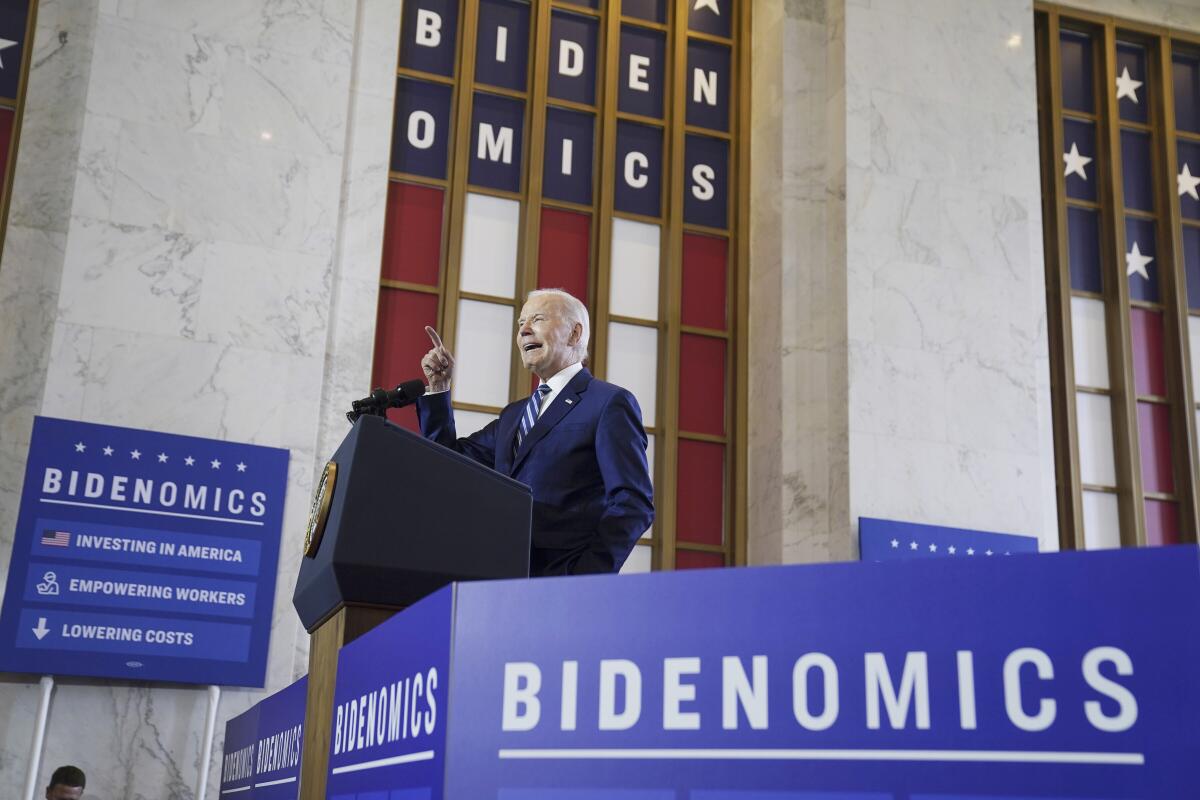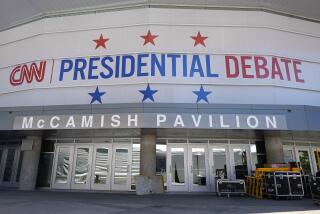How ‘Bidenomics’ looks now isn’t what matters. It’s how voters view it in a year that counts

WASHINGTON — President Biden wants to persuade Americans that the economy is better than they think — and that he deserves credit for turning it around.
He’s calling his strategy “Bidenomics,” and it’s already become a central theme of his coming reelection campaign.
“Bidenomics is working,” he said in a June 28 speech in Chicago.
That sales pitch will be an uphill struggle. Most Americans aren’t just skeptical that the economy is recovering, they’re downright pessimistic. A Gallup Poll last month reported that 66% think the economy is getting worse, not better. In an AP/NORC survey in May, 64% disapproved of the way Biden has handled the economy, including a daunting 39% of Democrats.
But even though most voters consider it a strike against him, it’s smart politics for Biden to claim ownership of the economy.
For one thing, it’s an issue no presidential candidate, especially an incumbent, can avoid.
“You can bet that Donald Trump is going to ask voters: Are you better off now than you were four years ago?” Democratic strategist Doug Sosnik predicted. “Biden has to have an answer to that.”
For another, the facts are slowly rallying to Biden’s side. The economy is growing by about 2% a year, job creation remains strong and — most important from a political standpoint — inflation has eased to 4% from last year’s peak of 9%. After two years in which prices were rising faster than wages, real incomes are slowly growing again.
“Bidenomics in action,” the president crowed recently when the Labor Department reported 209,000 new jobs were created in June.
White House officials have expressed frustration at voters’ failure to notice — let alone celebrate — those upbeat numbers.
Foreign-born labor adds to demand for services and holds down costs of farm products, child care and other goods and services.
But the public’s downbeat mood isn’t all that mystifying.
Inflation is easing, but prices are still stuck at inflation-fueled levels.
“The consumer price index is 16% higher than when Biden came to office,” Republican pollster David Winston pointed out.
And while growth appears strong, financial pundits keep warning that a recession could arrive any day now, especially if the Federal Reserve raises interest rates again.
Biden’s bet is that if the economy continues to improve, public opinion will evolve as well — and he wants to get credit when it does.
Hence “Bidenomics,” a brassy way to claim authorship of a recovery most voters don’t see yet.
“Good things are happening in the economy, but the average American doesn’t necessarily associate them with the president,” a Biden aide told me. “We need to make sure folks are making a direct link with his economic program.”
As an economic strategy, Bidenomics is essentially a collection of the industrial policy initiatives the president managed to get through Congress during his first two years in office, focusing on infrastructure, high-tech manufacturing and renewable energy.
As a political strategy, it boils down to job creation. Between now and election day, expect plenty of pictures of Biden, Vice President Kamala Harris and other officials admiring bridges, tunnels and high-tech assembly lines.
In South Carolina last week, the president touted the bridges his grants are rebuilding, and bragged that workers in new semiconductor factories will make as much as $100,000 a year — “and you don’t need a degree!”
But he didn’t have much to say about inflation, except for promising that it’s still “one of my top priorities.”
That omission drew grumbles from some centrist Democrats.
“I would have liked more of a narrative about Joe Biden, Inflation Fighter,” said Will Marshall, president of the moderate Progressive Policy Institute.
Needless to say, Republicans renewed their long-standing accusation that Biden’s spending programs were what fueled inflation in the first place.
But Biden doesn’t need to persuade every voter that his policies have been a triumph. If he can sway most of the Democrats who aren’t happy with his economic stewardship, his reelection campaign will be on firmer ground.
What matters isn’t how Bidenomics looks now, it’s how it looks a year from now, when voters are making up their minds.
That’s Biden’s gamble.
If the economy continues to improve, Biden will already have told voters why he deserves some credit.
If the Fed sends the economy into a recession, he won’t be able to claim those bragging rights — but he’ll be able to argue that he tried.
More to Read
Get the L.A. Times Politics newsletter
Deeply reported insights into legislation, politics and policy from Sacramento, Washington and beyond. In your inbox three times per week.
You may occasionally receive promotional content from the Los Angeles Times.












